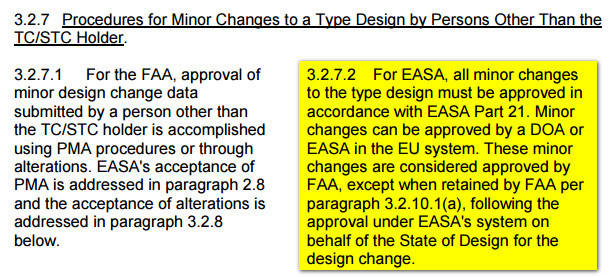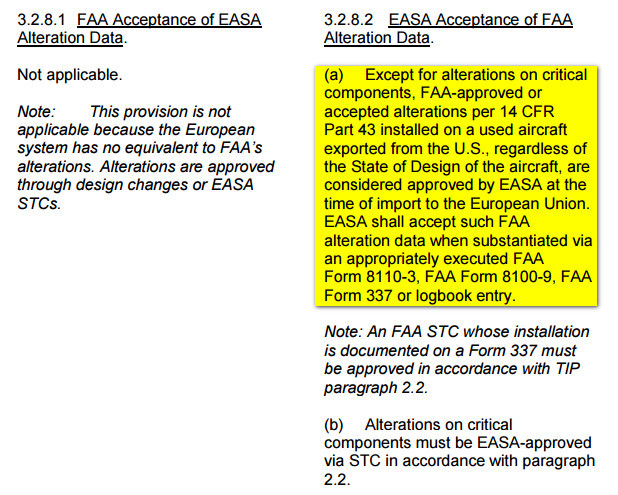What is the process where modifications are present?
I have heard of one process which is that an FAA DAR does an Export CofA and that covers the whole aircraft and EASA accepts that – within some limits which nobody seems to know in detail.
Then we have EASA acceptance of FAA STCs where the acceptance is for a specific aircraft only – see here.
Then of course we have straight EASA STCs so if the plane had a GTN750 that should be accepted directly.
Now let’s take a common real-world scenario: what happens if the N-reg plane has a number of FAA Minor Alterations? Let’s take one example where bits were installed in the RHS panel. All the bits are TSOd, there is no autopilot connection i.e. everything is “monitoring only”, and there is no EFIS. Examples might include a Davtron voltmeter, a Sandel EHSI, some instruments relocated (within the same panel) from the factory positions. The EHSI works similarly to a KI525 HSI which in the EASA world has quite often ended up there after an Aspen was installed on the LHS and displaced the KI525 and this is commonly done without any hassle e.g. I know of a D-reg TB20GT which has a KI525 there.
What (if any) EASA 21 recertification would be needed to support the transfer? Some EASA Part 21 shops say that everything has to be EASA recertified (before the CAA inspector will accept it) as if the mods were installed freshly on the EASA-reg.
Hmmm, well found… thank you for that, Guillaume. [ local copy ]

So, all FAA Minor Alterations must be recertified by an EASA part 21 company!
But that is curious since for exports to EASA-reg there is this concession which (via the “logbook entry” phrase) includes Minor Alterations:

Does anyone know how to interpret the above?
I got this from someone (don’t know the source):
Peter wrote:
The flight test was extreme in my eyes, up to VNE
That’s what the LAA requires for the renewal of the PTF for their fleet on an annual basis.
And the rate of climb at near max AUW. But the LAA still pass if below original factory figures.
(It’s a fail if the aircraft disintegrates at VNE, I believe.)
Has there been any update on this, @bookworm?
What is the current process for N-reg to EASA-reg?
AIUI you need an Export CofA which needs an FAA DAR and that is the biggest problem since there are very few over here and they are fully booked. Then you have to pass the local CAA inspection and that is the bit where a treaty on mod acceptance would be potentially very valuable. The Jun 2017 position appears to be above, from Guillaume, but to me this isn’t clear what it actually means in reality on the ground.
Is there any way to do a “local CAA pre inspection” before de-registering?
The FAA has been known to de-register planes when the Export CofA was done and the owner may not be aware of this… it has happened 
Peter wrote:
Has there been any update on this, @bookworm?What is the current process for N-reg to EASA-reg?
AIUI you need an Export CofA which needs an FAA DAR and that is the biggest problem since there are very few over here and they are fully booked. Then you have to pass the local CAA inspection and that is the bit where a treaty on mod acceptance would be potentially very valuable.
Is there any way to do a “local CAA pre inspection” before de-registering?
The FAA has been known to de-register planes when the Export CofA was done and the owner may not be aware of this… it has happened
The export CofA is needed going N to an EU register. The DARs are busy but seemingly available. I assume you can always ask a local Airworthiness inspector to give you a view in advance for a fee.
The request for deregistration could accidently be filed after export CofA is done but I can’t see how the CofA itself could lead to dereg.
The main problem explained to me is to ensure that the aircraft is not deregistered before the export CofA is issued as you would then need to reregister with the FAA, obtain it and then deregister again.
This is not really my area of expertise, but I think you’re misinterpreting the TIP when you say:
So, all FAA Minor Alterations must be recertified by an EASA part 21 company!
3.2.7.1 and 2 are telling you what the normal processes for alterations are within the respective systems, and then what the process is for acceptance of these alterations by the other authority.
3.2.7.2 does not mean that anything has to be recertified: it’s actually dealing with the reverse situation, of how design changes on an EASA aircraft are dealt with by the FAA when that aircraft goes to the N-reg. It says the FAA accepts major and minor EASA changes, except those related to noise.
For FAA to EASA, refer to paragraph 3.2.7.1, which says EASA accepts FAA alterations according to 3.2.8(.2). They are accepted unless they are on critical components.